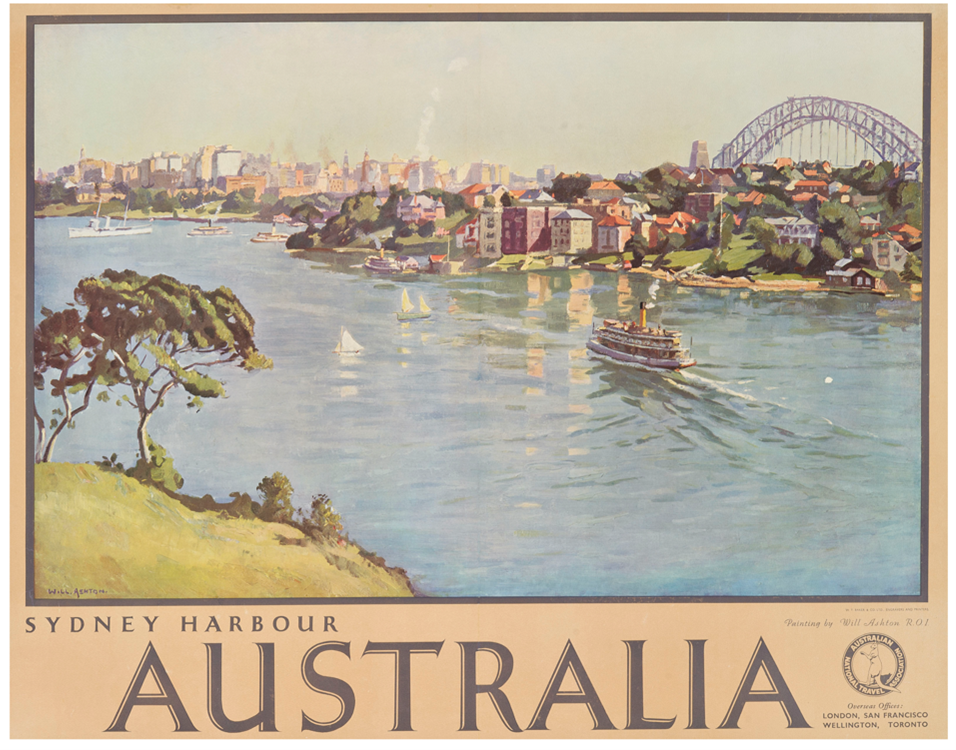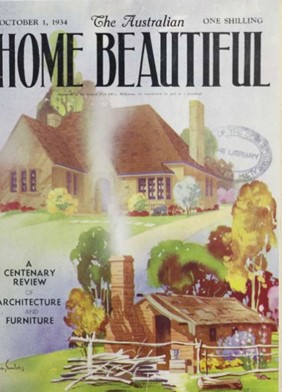Urban Citizenship in Flat-land
Urban Citizenship in Flat-Land
Melissa Miles and Geraldine Fela

The peace and harmony represented in Will Ashton’s image of Sydney belies a debate that was brewing in the 1930s about the city’s transformation. New blocks of residential flats, like those seen on the Harbour’s edge in Ashton’s poster, were going up by the hundreds. One commentator in The Home magazine warned that multi-story dwellings were ‘rising in Sydney’s beautiful slopes – and in her quiet valleys – like the spears of an approaching enemy.’ (The Home, October 1937, 31). The concern was not simply an aesthetic one. To this writer and countless others, at stake was domesticity itself, and the values, obligations and modes of social participation that defined how good citizens should live.
Commentators had long linked pride in one’s own free-standing home to narratives of nation-building and the public cultures of citizenship. In an article titled “Nation Builders” in Building magazine, George Taylor declared, ‘The Home Builder is inspired by the highest aims of citizenship, for his interest in the community becomes a personal one…’ (12 April 1913, 45). To another contributor to Building, care for the house and garden earned the homeowner ‘respect and prestige in his locality as a reward of good citizenship.’ (Building 12 October 1921, 71). Such ideas connecting citizenship with house and home were deeply gendered. Although the house’s public face was seen as the domain of the male breadwinner, women’s work in the home reflected their own ‘the field of citizenship… Woman has her place in the scheme of things level with man; but she must not mistake her sphere’ (Building, 12 August 1915, 97).

The October 1934 cover design of The Australian Home Beautiful is one of countless images that helped to affirm the emphasis on the free-standing home as a seat of civic pride and nation-building. The cover positions a frontier shack and modern suburban house as part of the same cultural lineage. As the well-tended garden and mown lawn of the ideal ‘garden suburb’ take the place of the colonial bush setting, the suburban home became part of a broader narrative of place and citizenship that both facilitated and obscured the reality of violent colonial dispossession.
The consistency with which commentators linked home-building, home-making and pride in one's own (stand-alone) home to public cultures of citizenship in the 1930s, was out of step with the experience of many Australians. Throughout the 1920s and 30s increasing numbers of Australians did find themselves, through choice or necessity, residing in apartment buildings. This saw renewed debate around how individuals and families should live – a debate connected to citizenship via a range of anxieties about class, race, health and sexuality.
Long-held perceptions of working-class tenements as unhygienic and immoral informed the notion that flats represented a threat to good citizenship. Former Prime Minister William ‘Billy’ Hughes was particularly concerned about implications of flat life for the nuclear family, describing ‘rows of towering flats’ as ‘the most ominous and most disturbing problem of Australia’s failing birth-rate.’ Hughes claimed the best way to address this threat was to provide men with work, ‘which was their heritage’, ‘decent houses and decent wages’ (The Herald, 5 November 1937, 3). There was also xenophobic element to the discourse. Journalist David McNicoll poured scorn on the growing numbers of ‘refugees’ ‘from the vassal States of Europe’ living in ‘uneducated, low-living standard hordes’ in flats
(Home, December 1, 1939, 40).
The perception, both real and imagined, that flats might attract ‘undesirables’ to the city and undermine ‘family life’ (Sydney Morning Herald, 28 April 1934, 15) perhaps reflected the dynamic, bohemian culture of Sydney’s inner-city flats. The rise in apartment buildings in Darlinghurst, King Cross and Potts Point helped facilitate the emergence of a gay or ‘camp’ subculture in these areas. Affordable for a ‘single’ person and conducive to a bohemian lifestyle, flats enabled people to escape the structures of the traditional family and find an alternative, and increasingly culturally diverse, community.
The discussion that these changes generated affirm that citizenship is far more than the right to participate formally in political life. Here, not only were the nation-state and the transforming city conceived as ‘spaces of citizenship’, private homes were figured as sites where the expectations of citizenship and social contribution were enacted and challenged.